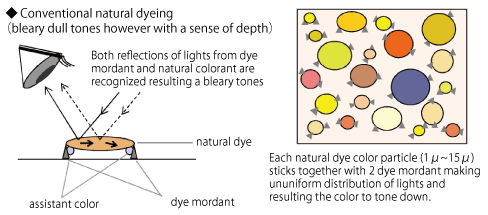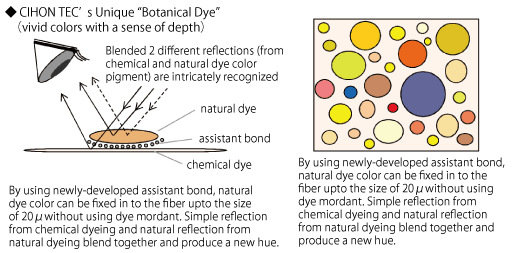【The Difference Between “Botanical Dye” and Conventional Natural Dyeing】
“Botanical Dye” produces sharp vivid colors while common natural dyeing
produces bleary dull colors.
※ Reference from CIHON TEC




Integrating the advantages of the two methods


【CIHON TEC’s Focus in “Botanical Dye”】
① Systematizing safe and sustainable technology
Under the concept of safety and sustainability, only natural colorants
from plants and minerals blended with harmless textile chemicals are used
to protect the buyer, the people in the manufacturing line and the surrounding
natural environment from being harmed. Environment and species preservation
are always in the mind. This technology is being systematized and is sustainable.
② Organized to match the shifting trends
The dye materials can be chosen from the commonly used 3,000 different
species among over 500,000 species available. This new technology enables
the color and the ingredients of the plant to be absorbed in the fabric
separately, and make it possible to produce any colors in shifting trends.
Producing color red for example, red pigment from an Old Rose (blending
chemical pigment and anthocyan from the rose) and the ingredients (quercitrin,
tellimagrandin, geraniol, etc.) are absorbed separately into fabric in
“Botanical Dye” process, while lac and cochineal are used to dye in conventional
natural dyeing process.
③ Better color fastness to meet the worldwide distribution standard
Conventional natural dyeing is not very suitable in distribution industry
sales in a sense that those items have less color fastness. “Botanical
Dye” enables better fastness using harmless chemical dye compound and amino
acid.
④ CIHON TEC wishes to disseminate plants/human interaction and benefit of
nature to draw people’s attention toward preservation of biological diversity.
⑤ CIHON TEC has the production line to dye various items (natural fiber,
artificial fiber, cotton, thread, textile fabric, etc.) in partnership
with 35 contract production factories throughout Japan, which enables collaboration
between different business fields such as food industry, beauty industry,
agriculture, pharmaceutical industry, etc.
